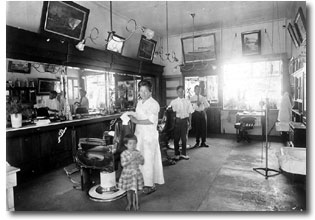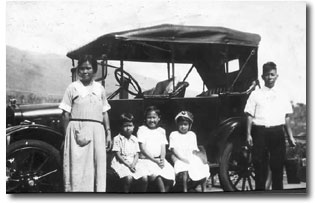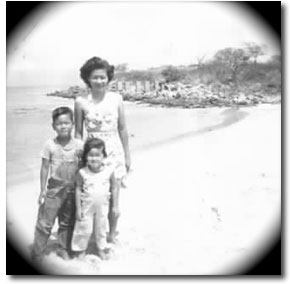|
Our Family History in
Hawaii
Over 100 years
of Maui Living
THE IMMIGRANTS Born
1860-1882
 It
was in the late 1880's with the wave of Japanese immigrants that
came to Hawaii from Japan to make money and return to Japan that
Carol Ansai Ball's grandfathers arrived on Maui. Brought over by the
sugar plantations, one ojichan (grandpa) worked for the Wailuku
Sugar Plantation and the other ojichan worked for the Pioneer Mill
Sugar Plantation in Lahaina. Lahaina ojichan opened a barber shop on
Dickenson Street in Lahaina after he had served his contract period
while the other grandfather raised children who continued work on
the sugar plantation. Both families led very different lives, as
different as the parts of Maui where they resided. The Wailuku
family was large, 11 children all of whom worked to support the
family as the head of the household suffered from chronic asthma,
hardly a healthy condition in the cane fields. The head of the
Lahaina family had his own business and was frugal and resourceful.
Further, he had only two girls to support. As part of the fabric of
the community the immigrants and their families were here to stay
and became important precursors of the Maui that we know today. It
was in the late 1880's with the wave of Japanese immigrants that
came to Hawaii from Japan to make money and return to Japan that
Carol Ansai Ball's grandfathers arrived on Maui. Brought over by the
sugar plantations, one ojichan (grandpa) worked for the Wailuku
Sugar Plantation and the other ojichan worked for the Pioneer Mill
Sugar Plantation in Lahaina. Lahaina ojichan opened a barber shop on
Dickenson Street in Lahaina after he had served his contract period
while the other grandfather raised children who continued work on
the sugar plantation. Both families led very different lives, as
different as the parts of Maui where they resided. The Wailuku
family was large, 11 children all of whom worked to support the
family as the head of the household suffered from chronic asthma,
hardly a healthy condition in the cane fields. The head of the
Lahaina family had his own business and was frugal and resourceful.
Further, he had only two girls to support. As part of the fabric of
the community the immigrants and their families were here to stay
and became important precursors of the Maui that we know today.
THE GREATEST GENERATION Born
1901-1924
All
of Carol Ball's fraternal grandfather and grandmother's large family
contributed to the family survival by plantation work and domestic
jobs in the community. Working for the plantation was a way of life
for most Maui residents during the early 1900's unless you had your
own business or worked for the bank. Carol's father, Toshio Ansai
(1908) worked in the warehouse at Wailuku Sugar as a clerk. Carol's
mother, Ruth Harimoto (1908) had been sent to McKinley High School
in Honolulu by her father whose barbershop was thriving on 10 cent
haircuts. She graduated from the Territorial Normal School as a
dental hygienist which merged shortly thereafter with the University
of Hawaii. How did these two young people meet, for at that time the
passage between Wailuku and Lahaina was a dirt path hugging the side
of the cliff? You can see the pali (cliff) road if you look above
you as you travel today from Wailuku to Lahaina. They met at a "bon
dance" held in all the communities where a Buddhist temple had been
built, a ceremonial tribute to those who had passed on . In the same
way that teenagers go to the mall to meet and greet instead of shop,
so did the Japanese American youth of yesteryear go to the bon dance
to meet others, especially of the opposite sex. They married and
moved in with Toshio's family in Wailuku. Eventually Toshio worked
his way up the company ladder to become manager of the Waihee Dairy
and retired as head of Industrial Relations for Wailuku Sugar
Company. Carol's mom served an important role as one of two dental
hygienists who traveled throughout Maui County providing teeth
cleaning services to public school children. She recalled that in
the initial years of her experience she loaded her dental equipment
locker, a large coffin-like wooden box, in the back of a pickup
truck and drove it from Wailuku to Kahakuloa on a narrow, one lane
road to the country school located there. A half a century later she
was still referred to as the "pretty lady in the white uniform who
used to come and clean our teeth" by oldsters reminiscing her
visits.
 Many
books and articles have been written about the Japanese in Hawaii
during this ebullient period as the children of these immigrants
became educated and found their places in Hawaii's society. Carol's
father began his political career during this time and was elected
to a seat on the Maui County Board of Supervisors. An important part
of the history of the Nisei (second generation Japanese born in
America) is their valorous service during World War II as part of
the 100th Battalion 442nd Regimental Combat Team. Carol's father
distinguished himself as a company First Sergeant serving with valor
in the European campaign. Returning to Hawaii at the conclusion of
the war, Toshio Ansai continued his political journey for over 25
years, serving on the Maui County Council and elected to the State
Senate. Retirement from active politics allowed Carol's father an
opportunity to serve in another capacity as chairman of the pivotal
Maui County Planning Commission. He and his committee helped pave
the way for many of the important developments that are enjoyed on
Maui today by residents and visitors alike. Many
books and articles have been written about the Japanese in Hawaii
during this ebullient period as the children of these immigrants
became educated and found their places in Hawaii's society. Carol's
father began his political career during this time and was elected
to a seat on the Maui County Board of Supervisors. An important part
of the history of the Nisei (second generation Japanese born in
America) is their valorous service during World War II as part of
the 100th Battalion 442nd Regimental Combat Team. Carol's father
distinguished himself as a company First Sergeant serving with valor
in the European campaign. Returning to Hawaii at the conclusion of
the war, Toshio Ansai continued his political journey for over 25
years, serving on the Maui County Council and elected to the State
Senate. Retirement from active politics allowed Carol's father an
opportunity to serve in another capacity as chairman of the pivotal
Maui County Planning Commission. He and his committee helped pave
the way for many of the important developments that are enjoyed on
Maui today by residents and visitors alike.
THE SILENT GENERATION Born
1925-1942
Carol
Ansai Ball was part of the "Silent Generation". The oldest of two
children born to Ruth and Toshi Ansai, Carol grew up in Waihee when
her father was the manager of the Waihee Dairy. The old Waihee Dairy
site is now the Waihee Coastal Dunes and Wetlands Preserve with
Carol's old childhood home still standing and used as the
caretaker's house. The acquisition of the 277 acre property by the
Maui Coastal Land Trust in 2003 saved it from development into a
golf resort and preserved this precious resource for future
generations. Carol moved to Wailuku with her mother and maid when
her father volunteered for military service during World War II.
From her home behind the Wailuku Library she traveled by bus to Kaunoa School in Spreckelsville, an English standard school which
was a public school but required an entrance exam. Passing the exam
required that applicants spoke no pidgin English (broken English
commonly spoken in Hawaii). Although initially separated along
racial lines, the English standard school ultimately broke down many
barriers among racial groups with a commonality of speaking "good
English". The English standard school was abolished in 1948 but it
took until 1960 for the final attendees to the English standard
system to graduate high school. Kaunoa School is now used as the
Senior Citizens Center where popular classes such as ukulele
lessons, lei making, and other crafts are taught. Graduating from
Baldwin High School in 1956, Carol left Maui for her first trip to
the mainland to enroll at the University of Michigan in Ann Arbor,
Michigan. Before the advent of jets the 13 hour trip by propeller
aircraft across the Pacific was followed by a 9 hour trip from LA to
Detroit. The only trips back to Maui were for summer vacation. It
was better than not going back to Maui until college graduation
which the previous generation experienced with travel to Hawaii by
ocean liner the only way to come home for those students. Just about
the only summer jobs that were available to college students of the
Silent Generation on Maui were at the Maui Pineapple Company. Field
work for both boys and girls, and factory work trimming pineapples
to prepare them for canning under the draconian supervision of the
foreladies was the typical cannery work. Privileged youngsters,
those with parents who had contacts, obtained jobs in the glove room
and laboratory. Carol had a job for four summers testing cans in the
laboratory. After graduating from Michigan and spending a year in
graduate school, Carol married an engineering student from Michigan,
Richard Ball. When he graduated with a degree in Civil Engineering,
the couple went West to the San Francisco Bay Area as many members
of the Silent Generation did, to follow the corporate life. Tiring
of the company routine, the Balls continued West to Carol's home in
Hawaii. Settling on Maui, Carol was home at last where members of
her generation could finally find a job at somewhere other than the
cannery or plantation. According to data in the Maui County General
Plan created in 2006, in 1956 the year Carol graduated from high
school, Maui attracted only 5% of the visitors to Hawaii and only 1%
of their expenditures.
 The
building of the Sheraton Hotel in Kaanapali marked the beginning of
job opportunities for Maui's population. Opening a construction firm
seemed like a smart thing to do on this island of growing
opportunity, eschewing suggestions from Carol's family for the
couple to become government workers. Kaahumanu Center was just being
built and Maui was a great place to bring up a family and the Ball
family had grown to a family of five. It seemed like Wailea, planned
at the end of the dusty rocky road dense with keawe trees on either
side, would never be built but its protracted initiation continued
the established opportunities for swimming at your own private beach
in Makena. Carol recalls how Maui had changed so dramatically over
the years before she returned. She remembered traveling to the Ansai
family beach house in Napili Bay where the Teahouse of the Maui Moon
now sits, when their beach house was the only structure on the keawe
tree filled bay. Around the corner when the Kapalua project broke
ground and gradually filled with condos, she cried over the seeming
desecration of the once pristine site. Decades later, she and her
family participated in one of the popular lotteries for a chance to
buy a luxury condo and were successful bidders for a unit at the
Kapalua Ridge Villas which they retained as the real estate market
plummeted, to sell it just before it regained its value. The
building of the Sheraton Hotel in Kaanapali marked the beginning of
job opportunities for Maui's population. Opening a construction firm
seemed like a smart thing to do on this island of growing
opportunity, eschewing suggestions from Carol's family for the
couple to become government workers. Kaahumanu Center was just being
built and Maui was a great place to bring up a family and the Ball
family had grown to a family of five. It seemed like Wailea, planned
at the end of the dusty rocky road dense with keawe trees on either
side, would never be built but its protracted initiation continued
the established opportunities for swimming at your own private beach
in Makena. Carol recalls how Maui had changed so dramatically over
the years before she returned. She remembered traveling to the Ansai
family beach house in Napili Bay where the Teahouse of the Maui Moon
now sits, when their beach house was the only structure on the keawe
tree filled bay. Around the corner when the Kapalua project broke
ground and gradually filled with condos, she cried over the seeming
desecration of the once pristine site. Decades later, she and her
family participated in one of the popular lotteries for a chance to
buy a luxury condo and were successful bidders for a unit at the
Kapalua Ridge Villas which they retained as the real estate market
plummeted, to sell it just before it regained its value.
Eventually
Carol took the real estate class in 1978 and passed it. With her
broker's license in hand, and bitten by the entrepreneurial spirit,
she opened her own brokerage, Carol Ball and Associates in 1980. For
many years the firm won statewide awards for sales performance.
Carol ran the firm she formed until 2007 when she and her husband,
Bob Yeager, whom she married in 1998, moved to Honolulu where Carol
earned her Master's Degree in Educational Psychology. Returning to
Maui, Carol purchased the rights to the Hawaii Real Estate Exam Book
which she presently revises and edits. She spends the rest of her
time teaching prelicensing classes at UH Maui College, something she
finds extremely rewarding. She feels that her ability to give her
students the skills to start a new life is a blessing and an honor.
She is also the author of an online prelicensing course launching in
2013 and Principal of the Carol Ball School of Real Estate offering
real estate prelicensing and continuing education. Besides
non-profit service in the community Carol served on the Hawaii Real
Estate Commission for eight years and as its chair in the final year
of her tenure. She serves as Chairman of the Board of Carol Ball
Inc. The Silent Generation had learned to speak.
Click
HERE To Continue...

Carol Ball
Inc.
dba
Carol Ball and
Associates
RB 11347
Maui Mall
70 E Kaahumanu Ave Ste A6
Kahului, HI 96732-2176
(808) 871-8807 • fax (808) 871-2462 •
info@carolball.com

© 2006-2014 Carol Ball and Associates • All Rights
Reserved |